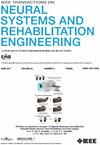痉挛产生受影响神经活动的基于spike的神经形态模型。
IF 4.8
2区 医学
Q2 ENGINEERING, BIOMEDICAL
IEEE Transactions on Neural Systems and Rehabilitation Engineering
Pub Date : 2025-04-02
DOI:10.1109/TNSRE.2025.3557044
引用次数: 0
摘要
痉挛是一种常见的运动症状,它会干扰肌肉收缩和运动。痉挛的适当管理需要识别其起源和治疗计划的推理。挑战的出现是因为痉挛可能源于皮层和皮层下通路的活动升高。没有现有的模型(动物或计算)能够涵盖所有导致痉挛的可能性,特别是外周原因,如反射亢进。为了弥补这一差距,这项工作开发了一种新的计算性的、基于spike的痉挛神经形态模型,名为NEUSPA。NEUSPA模型不是仅仅依赖于由α运动神经元、感觉传入、突触、骨骼肌和肌肉纺锤体组成的单突触脊髓回路,而是引入了两个额外的输入:加性(ADD)和乘法(MUL)。这些输入产生与速度相关的肌电反应。NEUSPA模型的有效性通过文献中的经典实验和收集的两例中风后上肢运动受影响患者的数据得到验证。该模型还用于模拟患者可能遇到的两种现实场景。模拟结果表明,额外输入引起的高反射足以产生痉挛性肌电反应。然而,与MUL输入(斜率= 0.471,p < 0.0001, r²= 0.92)相比,ADD输入(斜率= 0.628,p < 0.0001, r²= 0.96)对肌电发作更为敏感。此外,手指按压可变形物体的模拟表明,与未受损的情况相比,痉挛可以将持续时间从1.03秒增加到1.20秒。这些结果表明,NEUSPA有效地综合了异常生理数据,促进了神经康复的决策和机器学习。本文章由计算机程序翻译,如有差异,请以英文原文为准。
Spike-Based Neuromorphic Model of Spasticity for Generation of Affected Neural Activity
Spasticity is a common motor symptom that disrupt muscle contraction and hence movements. Proper management of spasticity requires identification of its origins and reasoning of the therapeutic plans. Challenges arise because spasticity might originate from elevated activity in both the cortical and sub-cortical pathways. No existing models (animal or computational) could cover all possibilities leading to spasticity, especially the peripheral causes such as hyperreflexia. To bridge this gap, this work develops a novel computational, spike-based neuromorphic model of spasticity, named NEUSPA. Rather than relying solely on a monosynaptic spinal loop comprising alpha motoneurons, sensory afferents, synapses, skeletal muscles, and muscle spindles, the NEUSPA model introduces two additional inputs: additive (ADD) and multiplicative (MUL). These inputs generate velocity-dependent EMG responses. The effectiveness of the NEUSPA model is validated using classic experiments from the literature and data collected from two post-stroke patients with affected upper-limb movements. The model is also applied to simulate two real-world scenarios that patients may encounter. Simulation results suggest that hyperreflexia due to extra inputs was sufficient to produce spastic EMG responses. However, EMG onsets were more sensitive to ADD inputs (slope =0.628, p <0.0001,> ${}^{{2}} =0.96$ ) compared to MUL inputs (slope =0.471, p <0.0001,> ${}^{{2}} =0.92$ ). Additionally, simulation of finger-pressing on a deformable object indicated that spasticity could increase the duration from 1.03s to 1.20s compared to a non-impaired condition. These results demonstrate that NEUSPA effectively synthesizes abnormal physiological data, facilitating decision-making and machine learning in neurorehabilitation.
求助全文
通过发布文献求助,成功后即可免费获取论文全文。
去求助
来源期刊
CiteScore
8.60
自引率
8.20%
发文量
479
审稿时长
6-12 weeks
期刊介绍:
Rehabilitative and neural aspects of biomedical engineering, including functional electrical stimulation, acoustic dynamics, human performance measurement and analysis, nerve stimulation, electromyography, motor control and stimulation; and hardware and software applications for rehabilitation engineering and assistive devices.

 求助内容:
求助内容: 应助结果提醒方式:
应助结果提醒方式:


